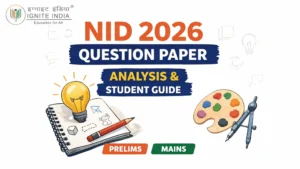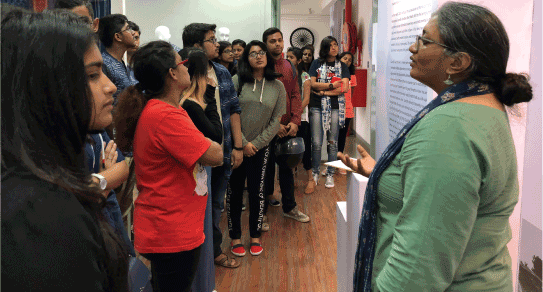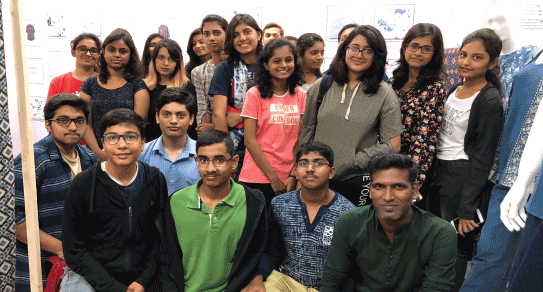
How to Choose the Right NIFT Campus in India: Ranking and Specializations
Getting into NIFT is a big achievement for any fashion and design aspirant. Once the results are out, the biggest question students face is how

The National Institute of Design (NID) is renowned for nurturing creative minds and fostering innovation in the field of design. Aspiring designers aiming to secure admission into NID must hone their drawing skills, as drawing forms the foundation of design education and practice. Whether you’re a novice or an experienced artist, continuous improvement in drawing abilities is essential for success in the NID 2024 admissions process.
Drawing serves as a fundamental tool for designers to communicate ideas, explore concepts, and convey emotions. From sketching initial concepts to creating detailed renderings, proficiency in drawing enables designers to articulate their vision effectively. NID places a strong emphasis on drawing during its admission process, making it imperative for applicants to showcase their drawing prowess.
Click here for more Information NID entrance coaching classes | Crack NID entrance coaching
Like any skill, drawing requires consistent practice to improve. Set aside dedicated time each day to sketch, doodle, or draw from observation. Experiment with different subjects, styles, and techniques to broaden your skill set and discover your unique artistic voice.
Develop your observational skills by studying the world around you. Pay attention to shapes, proportions, light, and shadow. Analyze the structure of objects and figures, breaking them down into basic forms. Practicing observational drawing strengthens your ability to capture detail and likeness accurately.
Explore a variety of drawing mediums, including pencils, charcoal, ink, and pastels. Each medium offers its own unique characteristics and challenges, allowing you to express yourself in different ways. Experimenting with different mediums enhances your versatility as an artist and expands your creative repertoire.
Understanding anatomy and perspective is essential for creating dynamic and lifelike drawings. Study the human figure and animal anatomy to grasp underlying structures and proportions. Learn the principles of linear perspective and foreshortening to create convincing spatial illusions in your drawings.
Engage with fellow artists, instructors, or online communities to receive feedback and constructive critique on your work. Constructive criticism helps identify areas for improvement and offers valuable insights into your strengths and weaknesses as an artist. Embrace feedback as a learning opportunity and use it to refine your skills.
While observational drawing is essential, don’t be afraid to unleash your creativity and draw from imagination. Experiment with imaginative storytelling, character design, and concept art to cultivate your narrative and conceptualization skills. Drawing from imagination fosters creativity and allows you to develop your personal style.
Carry a sketchbook with you wherever you go and use it to capture ideas, observations, and inspirations. A sketchbook serves as a visual diary of your artistic journey, allowing you to document your progress and brainstorm new concepts. Reviewing old sketches provides valuable insights into your artistic growth over time.
Check out other popular location NID Coaching in Bangalore | NID Coaching in Mumbai | NID Coaching in Delhi | NID Coaching in Pune
Improving your drawing skills is a continuous journey of exploration, experimentation, and refinement. By following these tips and committing to regular practice, you can enhance your drawing abilities and increase your chances of success in the NID 2024 admissions process. Remember, drawing is not just about creating pretty pictures; it’s about expressing ideas, emotions, and perspectives through the language of lines and shapes.
No, NID welcomes applicants from diverse backgrounds and skill levels. While prior experience in art and design is beneficial, what matters most is your passion, creativity, and willingness to learn.
Drawing plays a significant role in the NID admissions process, as it demonstrates your ability to visualize ideas, communicate visually, and think creatively. Strong drawing skills are essential for success in NID’s rigorous design programs.
Yes, NID accepts digital artwork as part of the portfolio submission. However, traditional drawing skills are still highly valued, so it’s advisable to showcase a mix of traditional and digital drawings to demonstrate your versatility.
Absolutely! NID values creativity, innovation, and potential. If drawing is not your strongest skill, focus on showcasing other strengths such as problem-solving abilities, conceptual thinking, and passion for design in your portfolio.
Some beneficial drawing exercises include gesture drawing, contour drawing, still life studies, and figure drawing. These exercises help improve hand-eye coordination, observation skills, and understanding of form and structure.


Getting into NIFT is a big achievement for any fashion and design aspirant. Once the results are out, the biggest question students face is how

Preparing for the NIFT entrance exam is a big step for any student who wants to enter the world of design and fashion. Many students

Choosing the right design college is not only about selecting a stream like fashion, product, animation, or communication design. It is also about understanding the

Fashion design has become one of the most exciting and creative fields today. Many students dream of learning fashion, drawing ideas, understanding fabrics, and creating

The Bachelor of Business Administration (BBA) is a popular undergraduate course for students aspiring to pursue a career in business management. With a rapidly evolving

The National Aptitude Test in Architecture (NATA) is one of the most important exams for students aiming to pursue a career in architecture. Whether you



By signing up for IgniteIndia. You agree to the Terms of Services and PrivacyPolicy of the platform.

Every year, thousands of students try to be accepted into NID; however, the majority of them are uncertain about one fundamental aspect: what kinds of

Preparing for the NID entrance exam can feel confusing when you are just starting. Many students know they want to study design, but they are

Choosing the right master’s degree can shape not just your career, but your entire future. For students who want strong career growth along with good

Getting into NIFT is a big achievement for any fashion and design aspirant. Once the results are out, the biggest question students face is how

Preparing for the NIFT entrance exam is a big step for any student who wants to enter the world of design and fashion. Many students

Choosing the right design college is not only about selecting a stream like fashion, product, animation, or communication design. It is also about understanding the
Fashion Designer, Educational and Career Counselor. He is an alumnus of NIFT and won the Best Graduation Project Award. He is guiding students from the past 15 years.
Fashion & Textile Designer, Educational and Career Counselor. He is an alumnus of NIFT and won the Best Graduation Project Award. He is guiding students from the past 10 years.
Ignite India Education is inspired by the former President of India Bharat Ratna Dr. APJ Abdul Kalam’s vision of “India Beyond 2020”. Our aim is to fulfil his vision by empowering society and transforming India into a developed nation through education.
Ignite India Education is inspired by the former President of India Bharat Ratna Dr. APJ Abdul Kalam’s vision of “India Beyond 2020”. Our aim is to fulfil his vision by empowering society and transforming India into a developed nation through education.
Fashion Designer, Educational and Career Counselor. He is an alumnus of NIFT and won the Best Graduation Project Award. He is guiding students from the past 15 years.
Fashion & Textile Designer, Educational and Career Counselor. He is an alumnus of NIFT and won the Best Graduation Project Award. He is guiding students from the past 10 years.
Ignite India Education is inspired by the former President of India Bharat Ratna Dr. APJ Abdul Kalam’s vision of “India Beyond 2020”. Our aim is to fulfil his vision by empowering society and transforming India into a developed nation through education.
Fashion & Textile Designer, Educational and Career Counselor. He is an alumnus of NIFT and won the Best Graduation Project Award. He is guiding students from the past 10 years.








Ignite India Alumni networks provide the long-term value to an educational institution by giving alumni the chance to stay in contact and continue to learn from each other long after they have left Institute. Ignite India is a Well Known Design Institute that equips students for success in career.
